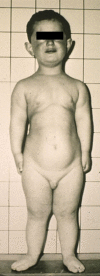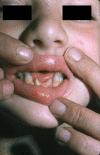Ellis-van Creveld syndrome
- PMID: 17547743
- PMCID: PMC1891277
- DOI: 10.1186/1750-1172-2-27
Ellis-van Creveld syndrome
Abstract
Ellis-van Creveld syndrome (EVC) is a chondral and ectodermal dysplasia characterized by short ribs, polydactyly, growth retardation, and ectodermal and heart defects. It is a rare disease with approximately 150 cases reported worldwide. The exact prevalence is unknown, but the syndrome seems more common among the Amish community. Prenatal abnormalities (that may be detected by ultrasound examination) include narrow thorax, shortening of long bones, hexadactyly and cardiac defects. After birth, cardinal features are short stature, short ribs, polydactyly, and dysplastic fingernails and teeth. Heart defects, especially abnormalities of atrial septation, occur in about 60% of cases. Cognitive and motor development is normal. This rare condition is inherited as an autosomal recessive trait with variable expression. Mutations of the EVC1 and EVC2 genes, located in a head to head configuration on chromosome 4p16, have been identified as causative. EVC belongs to the short rib-polydactyly group (SRP) and these SRPs, especially type III (Verma-Naumoff syndrome), are discussed in the prenatal differential diagnosis. Postnatally, the essential differential diagnoses include Jeune dystrophy, McKusick-Kaufman syndrome and Weyers syndrome. The management of EVC is multidisciplinary. Management during the neonatal period is mostly symptomatic, involving treatment of the respiratory distress due to narrow chest and heart failure. Orthopedic follow-up is required to manage the bones deformities. Professional dental care should be considered for management of the oral manifestations. Prognosis is linked to the respiratory difficulties in the first months of life due to thoracic narrowness and possible heart defects. Prognosis of the final body height is difficult to predict.
Figures
Similar articles
-
Novel and recurrent EVC and EVC2 mutations in Ellis-van Creveld syndrome and Weyers acrofacial dyostosis.Eur J Med Genet. 2013 Feb;56(2):80-7. doi: 10.1016/j.ejmg.2012.11.005. Epub 2012 Dec 7. Eur J Med Genet. 2013. PMID: 23220543
-
Two novel heterozygous mutations of EVC2 cause a mild phenotype of Ellis-van Creveld syndrome in a Chinese family.Am J Med Genet A. 2011 Sep;155A(9):2131-6. doi: 10.1002/ajmg.a.34125. Epub 2011 Aug 3. Am J Med Genet A. 2011. PMID: 21815252
-
Phenotypic Variation in Patients with Homozygous c.1678G>T Mutation in EVC Gene: Report of Two Mexican Families with Ellis-van Creveld Syndrome.Am J Case Rep. 2017 Dec 12;18:1325-1329. doi: 10.12659/ajcr.905976. Am J Case Rep. 2017. PMID: 29229899 Free PMC article.
-
[From gene to disease; EVC, EVC2, and Ellis-van Creveld syndrome].Ned Tijdschr Geneeskd. 2005 Apr 23;149(17):929-31. Ned Tijdschr Geneeskd. 2005. PMID: 15884406 Review. Dutch.
-
Ellis-van Creveld syndrome and Weyers acrodental dysostosis are caused by cilia-mediated diminished response to hedgehog ligands.Am J Med Genet C Semin Med Genet. 2009 Nov 15;151C(4):341-51. doi: 10.1002/ajmg.c.30226. Am J Med Genet C Semin Med Genet. 2009. PMID: 19876929 Review.
Cited by
-
Generation of Evc2/Limbin global and conditional KO mice and its roles during mineralized tissue formation.Genesis. 2015 Sep;53(9):612-626. doi: 10.1002/dvg.22879. Epub 2015 Aug 10. Genesis. 2015. PMID: 26219237 Free PMC article.
-
The Posterior Part Influences the Anterior Part of the Mouse Cranial Base Development.JBMR Plus. 2021 Dec 24;6(2):e10589. doi: 10.1002/jbm4.10589. eCollection 2022 Feb. JBMR Plus. 2021. PMID: 35229066 Free PMC article.
-
Sporadic familial ulnar hexadactyly of all four limbs.J Dermatol Case Rep. 2010 Apr 11;4(1):6-10. doi: 10.3315/jdcr.2010.1042. J Dermatol Case Rep. 2010. PMID: 21886738 Free PMC article.
-
Ellis-van Creveld Syndrome: A Rare Clinical Report of Oral Rehabilitation by Interdisciplinary Approach.Case Rep Dent. 2018 Jan 23;2018:8631602. doi: 10.1155/2018/8631602. eCollection 2018. Case Rep Dent. 2018. PMID: 29607224 Free PMC article.
-
Ellis-van Creveld Syndrome: A Case Report.Int J Clin Pediatr Dent. 2012 Jan;5(1):72-4. doi: 10.5005/jp-journals-10005-1138. Epub 2012 Feb 24. Int J Clin Pediatr Dent. 2012. PMID: 25206139 Free PMC article.
References
Publication types
MeSH terms
Substances
LinkOut - more resources
Full Text Sources
Medical




